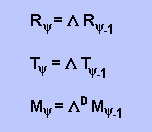
The SSCP draws attention to the self-evident, but often under-appreciated, fact that nature is organized in a hierarchical manner, from the smallest observable subatomic particles to the largest cosmological structures. Although the whole hierarchy appears to be quasi-continuous, the SSCP emphasizes that the cosmological hierarchy is highly stratified. While the observable portion of the entire hierarchy encompasses nearly 80 orders of magnitude in mass, three narrow mass ranges, each extending for only about 5 orders of magnitude, account for ≥ 99% of all mass observed in nature. These dominant mass ranges are referred to as the Atomic, Stellar and Galactic Scales. They constitute the discrete self-similar scaffolding of the observable portion of the quasi-continuous hierarchy.
The SSCP proposes that nature’s hierarchy extends far beyond our current observational limits on both large and small scales, and is probably unbounded in terms of scale, such that there are no largest or smallest objects (or Scales) in nature. The SSCP further proposes that the Atomic, Stellar and Galactic Scales, and all other fundamental Scales of nature’s infinite hierarchy, are rigorously interrelated by a new symmetry principle referred to as discrete cosmological self-similarity. For each class of particle, composite system or phenomenon on any given Scale, there is a discrete self-similar analogue on all other Scales. Mass (M), length (R) and time (T) parameters associated with analogues on neighboring Scales Ψ and Ψ-1 are related by the following set of discrete self-similar transformation equations.
 |
where Λ and D are dimensionless constants with values of 5.2 x 1017 and 3.174, respectively. The value of ΛD = 1.70 x 1056. The symbol Ψ is used as an index for keeping track of Scales, and
Ψ = {… , -2, -1, 0, +1, +2 , …}.
Usually the Atomic, Stellar and Galactic Scales are assigned Ψ = -1,Ψ = 0 and Ψ = +1, respectively. Any dimensional “constant” or parameter appearing in an equation associated with a given Scale must be transformed according to the scaling equations (1) – (3) in order to find the correct value for the counterpart “constant” or parameter on a neighboring Scale. When the discrete self-similarity is exact, then the theory is referred to as Discrete Scale Relativity.
"And I cherish more than anything else the analogies, my most trustworthy masters. They know all the secrets of Nature, and ought least to be neglected in Geometry."
- Johannes Kepler
Stellar/Atomic Analogies
The idea of strong analogies and direct morphological and kinematic self-similarity between atoms and stellar systems is one of the most troubling concepts for people considering the Self-Similar Cosmological Paradigm.
Why is this? Niels Bohr won the Nobel Prize in 1922 for his model of the hydrogen atom, which was based on a direct analogy to the Solar System. However, subsequent developments in Quantum Mechanics moved ever farther away from stellar/atomic analogies and they became synonymous with naivete, hard-headedness and/or mental impairment.
But the problem was in trying to compare atoms in low energy states with a stellar system (the Solar System) that was in an extremely high-energy state (principal quantum number n > 100).
Look at what happens when the atomic counterpart in the comparison is also in a very high-energy state. The following excerpts are from a recent paper by Kalinski et al in Physical Review A 67, 032503, 2003.
"We predict the existence of a self-sustained one-electron wave packet moving on a circular orbit in the helium atom. The wave packet is localized in space, but does not spread in time. This is a realization within quantum theory of a classical object that has been called a "Rutherford atom," a localized planetary electron on an unquantized circular orbit under the influence of a massive charged core." "[W]e provide the first demonstration of the existence of what has been called [14] a "Rutherford atom," i.e., the wave function for a single electron moving on an unquantized stable and nonspreading planetary orbit about a massive charged core." |
When a proper comparison is made between high-energy state atoms and high-energy state stellar systems, the stellar/atomic analogies and self-similarity are quite strong. This is not a naïve idea and one should not have to feel defensive about the concept. It is those who would deny strong stellar/atomic analogies who are in error.
"The authority of a thousand is not worth the humble reasoning of a single individual."
- Galileo